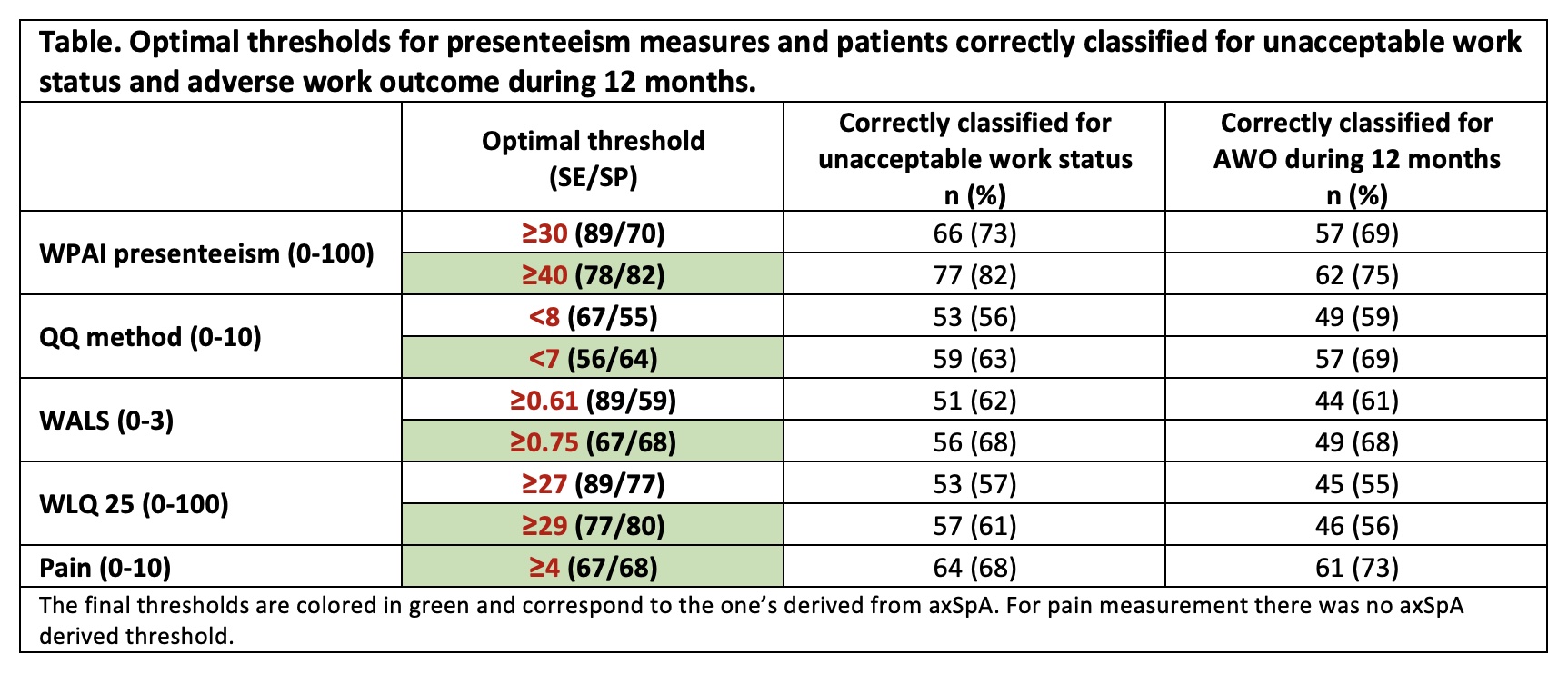Session Information
Date: Sunday, November 12, 2023
Title: (0380–0422) RA – Diagnosis, Manifestations, and Outcomes Poster I
Session Type: Poster Session A
Session Time: 9:00AM-11:00AM
Background/Purpose: Presenteeism is associated with lower work satisfaction and increased risk of future sick leave in rheumatic diseases. It is generally measured on a continuous scale; however, despite a lower precision, identifying persons with a meaningful level of presenteeism can improve interpretation in clinical studies and might be useful in routine practice. Recently, thresholds of meaning for presenteeism instruments were established for axial spondyloarthritis (axSpA). Our objectives were 1) To identify thresholds for presenteeism instruments that reflect unacceptable work status in patients with RA and whether those thresholds could predict future adverse work outcomes; 2) to assess in patients with RA the performance of presenteeism thresholds previously established in axSpA for the same instruments.
Methods: We used data from the 1-year multinational prospective study on Patient-Reported Outcomes in Employment Study in Rheumatoid Arthritis (RA-PROSE). Thresholds to determine when patients consider themselves in unacceptable work status were calculated at baseline for 4 presenteeism instruments (Work Productivity and Activity Impairment questionnaire -WPAI-, Quality and Quantity method -QQ-, Workplace Activity Limitations Scale -WALS- and Work Limitations Questionnaire -WLQ 25-) and for a patient global assessment of pain.
We created receiver operating characteristic (ROC) using as external criterion addressing one’s ability to perform current job satisfactorily. We used different approaches (75th percentile, Youden index, Liu method, nearest to 0.1) to determine the optimal cut-off, while balancing over-under diagnosis (i.e. specificity and sensitivity). Next, accuracy of thresholds to predict future adverse work outcome (AWO) throughout 12 months (defined as sick leave or long-term disability) was assessed. The recently developed presenteeism thresholds for axSpA were also tested.
Results: 105 employed patients were included: 77% females, mean age 48 (SD 9), with a symptom duration of 9.8 (8.7) years. 15% of the patients considered themselves in an unacceptable work status and 7 (8%) had at least one AWO during the 12 months.
All instruments showed good performance vs the external criterion (AUC >0.75) except for the QQ method (AUC 0.62) (figure). The table shows for each instrument (presenteeism and pain) the optimal thresholds and their performance to correctly identify an unacceptable work status and AWO during 12 months for the RA-specific threshold (1st row) and the available axSpA threshold (2nd row). Interestingly, the axSpA thresholds performed better to classify work status as unacceptable and to predict AWO (somewhat lower sensitivity but higher % of correctly classified patients). For adverse work outcome over 12 months, pain and WPAI performed better especially in predicting AWO.
Conclusion: Thresholds for presenteeism and pain representing unacceptable work status have been established for RA. Previously developed thresholds for axSpA showed an even better performance and are therefore the preferred to be used. WPAI performed the best and can be used to identify patients requiring more tailored care in order to avoid future AWO.
To cite this abstract in AMA style:
Capelusnik D, Ramiro S, Nikiphorou E, Maksymowych W, Magrey M, Marzo-Ortega H, Boonen A. Thresholds of Presenteeism Measurement Instruments for Unacceptable Work Participation and Future Adverse Work Outcomes in Rheumatoid Arthritis [abstract]. Arthritis Rheumatol. 2023; 75 (suppl 9). https://acrabstracts.org/abstract/thresholds-of-presenteeism-measurement-instruments-for-unacceptable-work-participation-and-future-adverse-work-outcomes-in-rheumatoid-arthritis/. Accessed .« Back to ACR Convergence 2023
ACR Meeting Abstracts - https://acrabstracts.org/abstract/thresholds-of-presenteeism-measurement-instruments-for-unacceptable-work-participation-and-future-adverse-work-outcomes-in-rheumatoid-arthritis/


